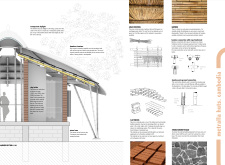5 key facts about this project
The Metralla huts in Cambodia represent an important connection between architecture and nature, located in a serene landscape that encourages quiet reflection. Inspired by "Metralla mesnyi," the national flower of Cambodia, the design aims to create a harmonious relationship between the structures and their environment. These huts are intended as spaces for meditation and self-discovery, inviting users to engage deeply with both the architecture and the surrounding landscape.
Design Concept
The design focuses on simplicity and clarity, featuring symmetrical forms that promote an organized spatial experience. Each hut is strategically oriented to support meditative practices, with a central space devoted to reflection. The overall layout encourages movement and mindfulness, allowing individuals to create a personal connection with the natural world as they explore their surroundings.
Material Utilization
Sustainable materials are central to the design, specifically bamboo, clay, and grass. Bamboo serves as a primary structural component due to its rapid growth and strength, making it suitable for the tropical climate. Clay is utilized to form adobe bricks that help regulate indoor temperatures, creating comfort in varying weather conditions. Grass is used for the roofing, providing natural insulation and enhancing the organic feel of the huts.
Community Engagement
The approach to construction invites community participation, fostering local involvement and increasing awareness of sustainable practices. The process lasts about seven weeks and includes building paths along with the huts themselves, ensuring minimal disruption to the existing environment. This inclusive practice not only strengthens community ties but also highlights the significance of local materials and craftsmanship.
Unique Aspects of Design
One notable feature of the Metralla huts is the emphasis on spiritual engagement, with designated areas for walking meditation. This careful integration of meditation into the design reflects a concern for the user experience. The arrangement promotes an environment that nurtures reflection and tranquility, highlighting the importance of emotional well-being.
Each hut includes large openings that enhance natural ventilation, allowing fresh air to flow freely. This design choice fosters a connection between indoor and outdoor spaces, enriching the sensory experience for those who occupy them.






















































